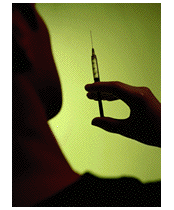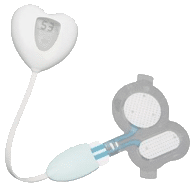Michael Fumento
Factual · Powerful · Original · Iconoclastic
Medicine's Ouchless Future
January 01, 2003 · Michael Fumento · Scripps Howard News Service · BiotechIt’s an annual tragedy. About 114,000 Americans are hospitalized, 36,000 die, and billions of dollars in health care costs and work time are lost because so many of us won’t roll up our sleeves for a cheap flu shot.

Needles are going the way of the slide rule.
Of course, it’s not the sleeve-rolling or the price that bothers us; it’s those darned needles. It’s strange that so many should suffer and die over fear of a small sting. But rather than fight human nature, MedImmune Inc. of Gaithersburg, Md., has accommodated it by winning FDA approval for its FluMist flu vaccine that’s sprayed up the nose.
FluMist appears at least as effective as the injections, although it hasn’t yet received FDA approval for those who need flu vaccines the most, the elderly. But MedImmune is breaking new ground for a future without shots, meaning greater compliancy among patients and ultimately less illness.
"It’s very exciting for us to have the first nose spray to prevent contagious disease and it’s an exciting portend for the future of fighting disease," MedImmune Senior Director of Corporate Communications Lori Weiman told me.
Indeed, slowly needles are going the way of the slide rule.
Some non-needle delivery systems are already available, such as various devices from New-Jersey-based Bioject Medical Technologies Inc. that use compressed gas or a coiled spring to shoot medicine either into muscle or just below the skin. They’ve already delivered some eight million injections, including all types of vaccines, insulin, and many other drugs.
Bioject devices aren’t entirely pain-free. "You feel a mild sensation," says Vice President of Business Development Michael Redmond. But the lack of a needle itself may be more important than the lack of pain, as one study showed that 85 percent of test subjects prefer the Bioject devices over traditional injections.
No needles also means no needle stick injuries. Hundreds of thousands of Americans are hurt this way annually, exposing them to potentially lethal blood-borne pathogens such as HIV; hepatitis B; and hepatitis C.
Along with vaccines, the largest market for needle-free drug administration is insulin for both types of diabetes. Those with type 1 diabetes generally need an injection at each meal and one at night, while persons with type 2 usually need fewer injections. Sadly the obesity epidemic has led to an epidemic of type 2, such that a third of Americans are now expected to ultimately contract the disease.
The problem with insulin is that it’s a large molecule protein, meaning that if taken orally the gut destroys it. But many companies are trying to hurdle that barrier.
Nektar Therapeutics of San Carlos, California is in late-stage testing with its inhalable Exubera insulin powder, which it’s developing with partners Pfizer Inc. and Aventis.
A nifty little device I saw demonstrated at the BIO 2003 convention in June is the first electronic inhaled-insulin-system, called AERx. It delivers aerosolized liquid insulin via a unique system that guides users to the correct breathing technique to ensure deep-lung delivery. It even downloads data that the patient and doctor can use to potentially improve compliance. Developed by Aradigm Corporation of Hayward, California and Denmark’s Novo Nordisk, it’s also in late human trials.

The Vyteris "Active Transdermal System," including the patch itself on the right and the dose controller on the left.
Unfortunately, while inhaled insulin may eliminate the short-acting mealtime injections, type 1 diabetics would still need a long-acting shot at bedtime. Thus the Holy Grail of insulin administration is pills or patches.
Emisphere Technologies in Tarrytown, N.Y., has managed to squeeze and reshape insulin molecules to slip them across cell membranes and allow them to be taken in pills. Once inside the cell, these stealth molecules spring back into proper shape and go to work. The drug has sparkled in early human testing and holds the promise of eliminating all shots for all diabetics.
Transdermal patches are already commonly used for some drugs such as nicotine and estradiol (estrogen), but the skin refuses to admit anything but small molecules. That prevents us from drowning when we take a bath by blocking water molecules, but it also puts a "Keep out!" sign for protein drugs.
Scientists at ALZA in Mountain View, California and Vyteris in Fair Lawn, New Jersey, however, are experimenting with painless pulses of electricity delivered from small wearable batteries to shove medicine from patches across the skin barrier. Other companies are using ultrasound for the same purpose, squeezing across big fat molecules like insulin and pain medicines.
Someday we’ll associate needles with little more than sewing, knitting, and acupuncture. Meanwhile, in whatever form you take it, please get that flu shot this fall.
